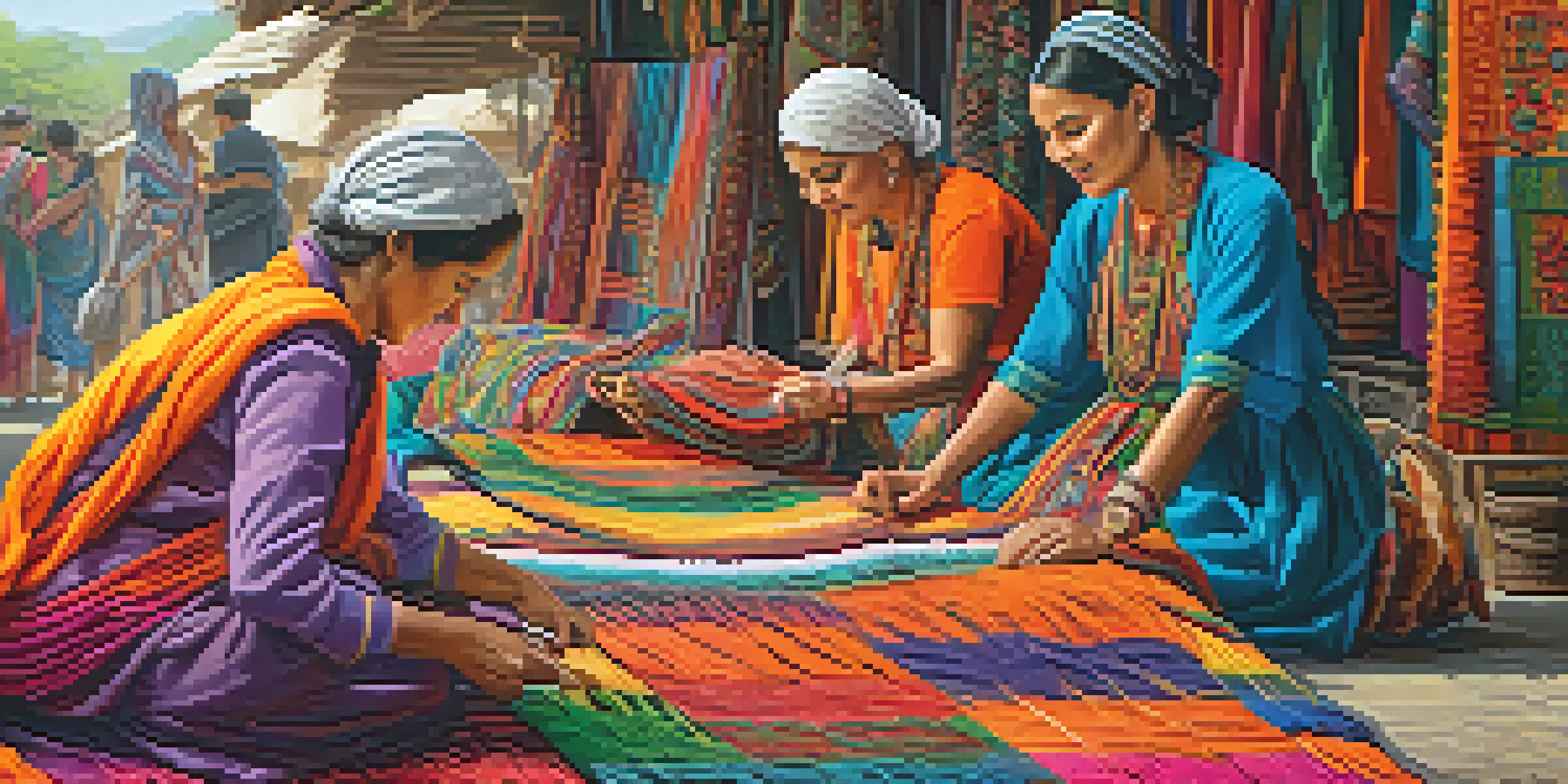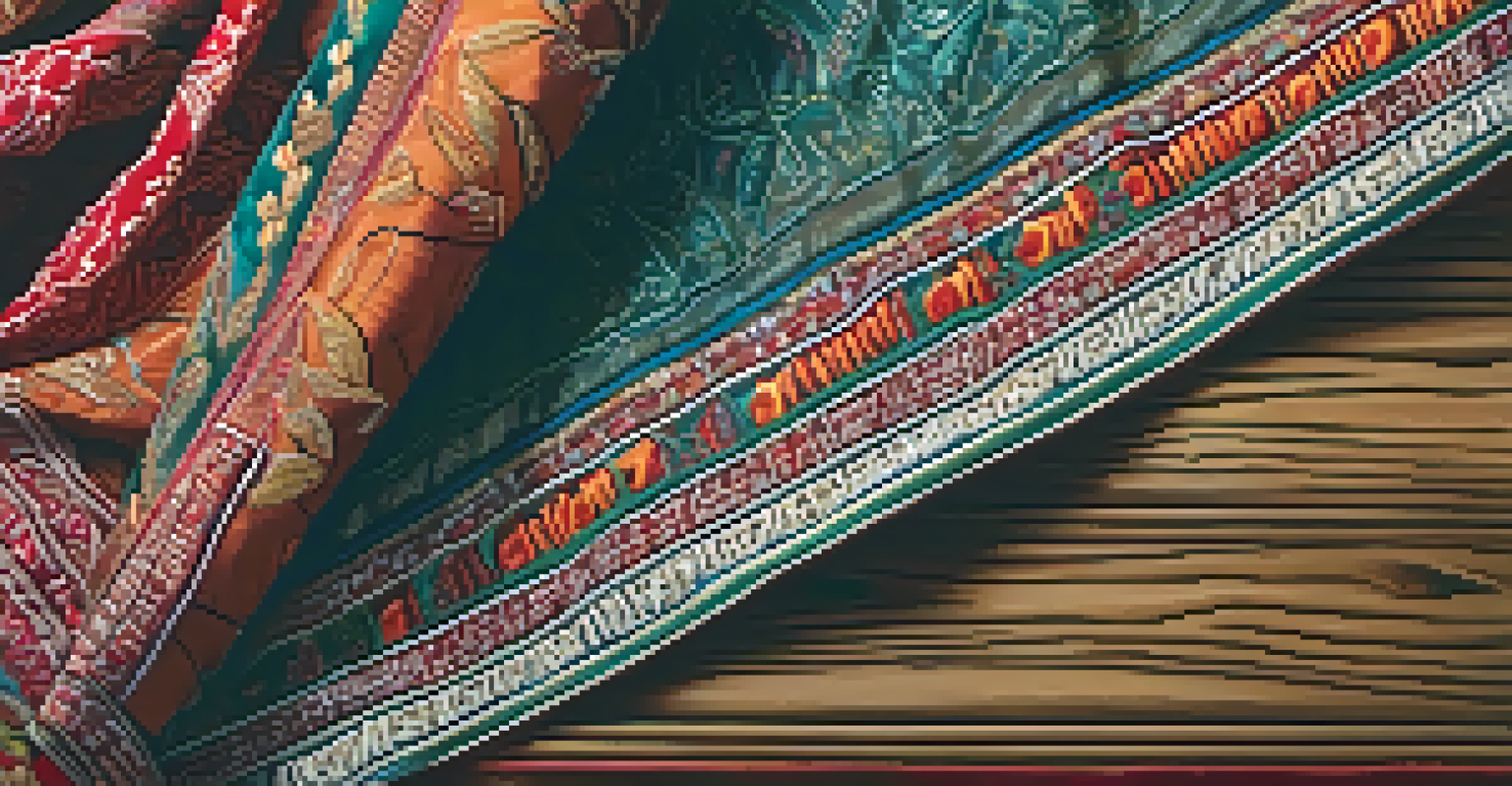Reviving Traditional Fashion: A Path to Cultural Sustainability

Understanding Traditional Fashion and Its Importance
Traditional fashion encompasses clothing styles that are deeply rooted in cultural history. These garments often tell stories, reflecting the values, beliefs, and aesthetics of different communities. By reviving traditional fashion, we not only celebrate these narratives but also ensure that they continue to thrive in a modern context.
Fashion is the armor to survive the reality of everyday life.
The importance of traditional fashion extends beyond aesthetics; it fosters a sense of identity and belonging. For many, wearing traditional attire is a way to connect with their heritage and express pride in their culture. This connection can be particularly significant in a globalized world where cultural identities can sometimes feel diluted.
Moreover, traditional fashion can serve as a bridge between generations, allowing older and younger individuals to share experiences and knowledge. By engaging with these styles, we cultivate an appreciation for our roots, which is essential for cultural sustainability.
The Role of Artisans in Preserving Traditional Techniques
Artisans play a crucial role in keeping traditional fashion alive. These skilled individuals possess the knowledge of age-old techniques, such as weaving, embroidery, and dyeing, which are often passed down through generations. Their expertise not only preserves the craft but also enhances the uniqueness of each piece created.

Supporting artisans means investing in local economies and promoting sustainable practices. When you purchase handmade garments, you are contributing to the preservation of craftsmanship that might otherwise fade away. This support is vital for ensuring these techniques remain vibrant and relevant.
Cultural Identity Through Fashion
Wearing traditional attire helps individuals connect with their heritage and express pride in their cultural identity.
Additionally, artisans bring innovation to traditional designs, adapting them for contemporary tastes while maintaining cultural integrity. This balance between tradition and modernity can create exciting new fashion trends that resonate with a broader audience.
Cultural Sustainability: Why It Matters Now More Than Ever
Cultural sustainability refers to the ability of cultures to maintain their distinctiveness and vitality over time. In our rapidly changing world, preserving cultural practices is essential for fostering diversity and understanding among communities. Traditional fashion is a key component of this sustainability, as it embodies cultural heritage.
Cultural identity is not something that can be lost in a globalized world; it is something that must be actively preserved and celebrated.
By prioritizing cultural sustainability, we not only honor our past but also create a foundation for future generations. Engaging with traditional fashion encourages younger individuals to learn about their roots, ensuring that cultural practices are not lost over time. It cultivates a sense of pride and responsibility towards one's heritage.
Moreover, cultural sustainability can have positive social impacts, fostering respect and appreciation for different cultures. In an age where global homogeneity threatens individuality, embracing traditional fashion can serve as a powerful statement of identity and solidarity.
Fashion Industry's Shift Towards Ethical Practices
The fashion industry is undergoing a significant transformation, with more brands prioritizing ethical practices and sustainability. This shift is crucial, given the environmental and social challenges posed by fast fashion. Reviving traditional fashion aligns perfectly with this movement, as it emphasizes quality, craftsmanship, and cultural significance.
Brands that incorporate traditional fashion often focus on ethical sourcing and fair trade, ensuring that artisans are fairly compensated for their work. This commitment not only supports local economies but also helps to preserve traditional techniques and knowledge. By choosing ethical options, consumers can contribute to a more sustainable fashion landscape.
Artisans Preserve Cultural Techniques
Skilled artisans keep traditional fashion alive by passing down techniques and creating unique, handmade garments.
Furthermore, the rise of conscious consumerism means that individuals are increasingly seeking out brands that reflect their values. By promoting traditional fashion, the industry can attract a customer base that prioritizes cultural integrity and sustainability, leading to a more responsible approach to fashion.
The Influence of Social Media on Traditional Fashion Revival
Social media has become a powerful platform for promoting traditional fashion, allowing artisans and designers to showcase their work to a global audience. This visibility fosters appreciation for diverse cultural expressions and encourages consumers to explore traditional garments. Platforms like Instagram and TikTok have made it easier than ever for these styles to gain traction.
Moreover, social media enables storytelling, allowing brands to share the narratives behind their traditional pieces. When consumers understand the history and significance of a garment, they are more likely to appreciate its value and choose to invest in it. This connection can lead to increased demand for traditional fashion.
As influencers and fashionistas embrace traditional styles, they help to reshape modern fashion trends. This blending of contemporary and traditional aesthetics can lead to a resurgence of interest in cultural garments, paving the way for a sustainable fashion future.
Challenges in Reviving Traditional Fashion
While reviving traditional fashion is a noble endeavor, it is not without its challenges. One major issue is the risk of cultural appropriation, where elements of a culture are used without understanding or respect. This can lead to commodification, stripping traditional garments of their meaning and significance.
Additionally, there's the challenge of balancing authenticity with modern consumer preferences. As artisans adapt traditional techniques for contemporary fashion, they must remain true to their cultural roots while also appealing to a broader audience. This delicate balance can be difficult to achieve, yet it's essential for sustaining cultural heritage.
Social Media Boosts Traditional Styles
Platforms like Instagram and TikTok promote traditional fashion, allowing artisans to reach a global audience and share their cultural stories.
Lastly, there is often limited access to resources and markets for artisans, making it hard for them to thrive in a competitive environment. Addressing these challenges requires collective efforts from consumers, brands, and communities to ensure that traditional fashion is revived respectfully and sustainably.
Creating a Future for Traditional Fashion
The future of traditional fashion lies in collaboration between artisans, designers, and consumers. By working together, we can create a vibrant ecosystem that supports cultural sustainability. This can be achieved through initiatives that promote education, awareness, and accessibility to traditional fashion.
Moreover, incorporating traditional fashion into mainstream markets can help elevate its status, making it more desirable to a wider audience. Collaborations between emerging designers and traditional artisans can lead to innovative creations that honor both tradition and modernity.

Ultimately, embracing traditional fashion is about more than just clothing; it's about preserving cultural stories and identities. By choosing to support and wear traditional garments, we can contribute to a future where cultural heritage is celebrated and sustained for generations to come.